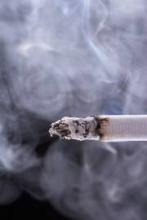User login
ATLANTA – Children who are exposed to secondhand tobacco smoke have an increased risk of urinary urgency, frequency, and incontinence, prospective data from a small study have shown.
Among children with these bladder symptoms, 28% were exposed to tobacco smoke on a daily basis – 13% higher than the overall child exposure rate in New Jersey, Dr. Kelly Johnson said at the annual meeting of the American Urological Association.
In addition to irritating a child’s bladder, childhood exposure to tobacco smoke is directly linked to the development of bladder cancer as an adult, she said in a press briefing.
Dr. Johnson, chief urology resident at the Robert Wood Johnson University Hospital, New Brunswick, N.J., presented prospective data on 45 children, aged 4-17 years, who presented with irritative bladder symptoms – frequency, urgency, and incontinence.
She used the Harvard Children’s Health and the Children’s Neurotoxicant Exposure studies to classify tobacco smoke exposure. The patients’ symptom severity was scored with the Dysfunctional Voiding Scoring System and classified as very mild, mild, Drmoderate, or severe.
About half of the group (21) had very mild or mild symptoms, while the remainder had symptoms scored as moderate or severe.
None of the children with mild scores were exposed to secondhand smoke on a daily basis, and none had mothers who smoked. However, 23% of those with moderate to severe scores had mothers who smoked, and 50% were exposed to smoke in a car on a regular basis.
"On our measures of environmental tobacco smoke exposure, children with greater exposure had significantly higher symptom severity scores than children who weren’t exposed," Dr. Johnson said. "This relationship was particularly striking for the younger children aged 4-10 years old."
Physicians who see children with bladder dysfunction should ask parents about smoke exposure, she advised – not only because of its effect on the current problems, but because of its proven dangers as the child grows up.
"Tobacco smoke contains chemicals that are known bladder irritants in both children and adults, and European studies have shown a strong relationship between adult bladder cancer and childhood tobacco smoke exposure.
The discussion of a child’s urinary symptoms provides a very good opportunity to speak to parents about smoking cessation, she added.
"It’s a teachable moment," that can have a long-lasting positive impact on both the child and the parent. "Unlike other risky behaviors, which affect only the person who engages in them, smoking poses substantial health risks to those not involved in the process," she said.
Dr. Johnson said she had had no relevant financial disclosures.
ATLANTA – Children who are exposed to secondhand tobacco smoke have an increased risk of urinary urgency, frequency, and incontinence, prospective data from a small study have shown.
Among children with these bladder symptoms, 28% were exposed to tobacco smoke on a daily basis – 13% higher than the overall child exposure rate in New Jersey, Dr. Kelly Johnson said at the annual meeting of the American Urological Association.
In addition to irritating a child’s bladder, childhood exposure to tobacco smoke is directly linked to the development of bladder cancer as an adult, she said in a press briefing.
Dr. Johnson, chief urology resident at the Robert Wood Johnson University Hospital, New Brunswick, N.J., presented prospective data on 45 children, aged 4-17 years, who presented with irritative bladder symptoms – frequency, urgency, and incontinence.
She used the Harvard Children’s Health and the Children’s Neurotoxicant Exposure studies to classify tobacco smoke exposure. The patients’ symptom severity was scored with the Dysfunctional Voiding Scoring System and classified as very mild, mild, Drmoderate, or severe.
About half of the group (21) had very mild or mild symptoms, while the remainder had symptoms scored as moderate or severe.
None of the children with mild scores were exposed to secondhand smoke on a daily basis, and none had mothers who smoked. However, 23% of those with moderate to severe scores had mothers who smoked, and 50% were exposed to smoke in a car on a regular basis.
"On our measures of environmental tobacco smoke exposure, children with greater exposure had significantly higher symptom severity scores than children who weren’t exposed," Dr. Johnson said. "This relationship was particularly striking for the younger children aged 4-10 years old."
Physicians who see children with bladder dysfunction should ask parents about smoke exposure, she advised – not only because of its effect on the current problems, but because of its proven dangers as the child grows up.
"Tobacco smoke contains chemicals that are known bladder irritants in both children and adults, and European studies have shown a strong relationship between adult bladder cancer and childhood tobacco smoke exposure.
The discussion of a child’s urinary symptoms provides a very good opportunity to speak to parents about smoking cessation, she added.
"It’s a teachable moment," that can have a long-lasting positive impact on both the child and the parent. "Unlike other risky behaviors, which affect only the person who engages in them, smoking poses substantial health risks to those not involved in the process," she said.
Dr. Johnson said she had had no relevant financial disclosures.
ATLANTA – Children who are exposed to secondhand tobacco smoke have an increased risk of urinary urgency, frequency, and incontinence, prospective data from a small study have shown.
Among children with these bladder symptoms, 28% were exposed to tobacco smoke on a daily basis – 13% higher than the overall child exposure rate in New Jersey, Dr. Kelly Johnson said at the annual meeting of the American Urological Association.
In addition to irritating a child’s bladder, childhood exposure to tobacco smoke is directly linked to the development of bladder cancer as an adult, she said in a press briefing.
Dr. Johnson, chief urology resident at the Robert Wood Johnson University Hospital, New Brunswick, N.J., presented prospective data on 45 children, aged 4-17 years, who presented with irritative bladder symptoms – frequency, urgency, and incontinence.
She used the Harvard Children’s Health and the Children’s Neurotoxicant Exposure studies to classify tobacco smoke exposure. The patients’ symptom severity was scored with the Dysfunctional Voiding Scoring System and classified as very mild, mild, Drmoderate, or severe.
About half of the group (21) had very mild or mild symptoms, while the remainder had symptoms scored as moderate or severe.
None of the children with mild scores were exposed to secondhand smoke on a daily basis, and none had mothers who smoked. However, 23% of those with moderate to severe scores had mothers who smoked, and 50% were exposed to smoke in a car on a regular basis.
"On our measures of environmental tobacco smoke exposure, children with greater exposure had significantly higher symptom severity scores than children who weren’t exposed," Dr. Johnson said. "This relationship was particularly striking for the younger children aged 4-10 years old."
Physicians who see children with bladder dysfunction should ask parents about smoke exposure, she advised – not only because of its effect on the current problems, but because of its proven dangers as the child grows up.
"Tobacco smoke contains chemicals that are known bladder irritants in both children and adults, and European studies have shown a strong relationship between adult bladder cancer and childhood tobacco smoke exposure.
The discussion of a child’s urinary symptoms provides a very good opportunity to speak to parents about smoking cessation, she added.
"It’s a teachable moment," that can have a long-lasting positive impact on both the child and the parent. "Unlike other risky behaviors, which affect only the person who engages in them, smoking poses substantial health risks to those not involved in the process," she said.
Dr. Johnson said she had had no relevant financial disclosures.
EXPERT ANALYSIS FROM THE ANNUAL MEETING OF THE AMERICAN UROLOGICAL ASSOCIATION
Major Finding: Half of children with moderate to severe bladder symptoms are exposed to secondhand tobacco smoke on a regular basis.
Data Source: The data were from a prospective cohort study of 45 children.
Disclosures: Dr. Johnson said she had no relevant financial disclosures.

